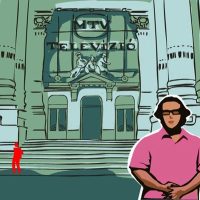Tibor Hajas: We state that this wall does not exist, 1974 Photo: Béla Kónya, Ludwig Museum – Museum of Contemporary Art
Csaba Nemes: Remake I-X., 2007, video still, Ludwig Museum – Museum of Contemporary Art
This time, our selection for the new exhibition of the collection mainly comprises artworks created or acquired after 1989. On the foundations of the donation by Peter and Irene Ludwig, we have built a valuable and well-structured international collection of more than five hundred pieces, bearing the unique characteristics of the post-socialist region. The present selection explores such notions and phenomena as the change of regime and democratic transition, history, utopias, the street, the body and the space – all this through about 80 remarkable and thought-provoking works of art. A collateral exhibit accompanying the exhibition digests the history of the founding of the museum, via works of art, contemporaneous documents and photographs.
Peter and Irene Ludwig, founders of the Ludwig Museum – Museum of Contemporary Art in Budapest, are regarded as the most significant and influential art collectors of the post-World War II period, and rightly so. They have passed on the majority of the artworks they have purchased to public collections; their donations, consignments and foundations were used to develop institutions and establish new museums, meanwhile they played an important mediatory role between the United States and Europe, as well as “West” and “East”. The name Ludwig now denotes more than ten museums across the globe (Aachen, Cologne, Vienna, Koblenz, Oberhausen, Saint Petersburg, etc.); one of these is the Ludwig Museum of Budapest, established in 1989, immediately before the change of regime.
Peter Ludwig first visited Budapest in 1983, when Műcsarnok / Kunsthalle Budapest presented a representative, spectacular exhibition from the collection of the Museum Moderner Kunst Stiftung Ludwig Wien, entitled Internationale Kunst seit 1960 (International Art Since 1960). In February 1987, Peter Ludwig visited Budapest once more, with the intention of establishing a new museum. The ministry commissioned Loránd Bereczky, director of the Hungarian National Gallery to conduct the negotiations, as a result of which the National Gallery opened another exhibition featuring Internationale Kunst aus der Sammlung Ludwig (International Art from the Ludwig Collection) on 16 October 1987. In March 1988 the Hungarian Ludwig Foundation was established, and in February 1989 an exhibition of Hungarian artists entitled Kunst Heute in Ungarn (Hungarian Art Today) opened at Neue Galerie – Sammlung Ludwig of Aachen.
On 21 March 1989, a little after the opening of the exhibition of Hungarian artists in Aachen, the founding contract of the Ludwig Museum in Hungary was ceremoniously signed in Budapest. The signers were Peter and Irene Ludwig and the Ludwig Stiftung of Aachen on the German side, and the Ministry of Culture and the Hungarian National Gallery on the Hungarian side. The contract stipulated the establishment of a new museum of modern art in Budapest (UNGARISCHES LUDWIG-MUSEUM für internationale moderne Kunst / HUNGARIAN LUDWIG MUSEUM for International Modern Art) on the foundations of seventy artworks donated by the Ludwigs to Hungary, and a further 95 artworks to be consigned later on. The first permanent exhibition of Ludwig Museum opened under the direction of the Hungarian National Gallery on 4 June 1991 in Building ‘A’ of the Buda Castle, with the title Zeitgenössische Kunst aus der Sammlung des Ludwig-Museums Budapest und der Ungarischen Nationalgalerie (Contemporary Art from the Collection of Ludwig Museum Budapest and the Hungarian National Gallery).
In 1992, the foundation’s international board of trustees appointed Katalin Néray as director of the museum, which she led until 2007. From 1993 until 1996 the museum operated as a specialised museum affiliated to National Gallery and with the establishment of the Museum of Contemporary Art in 1996, the institution became fully independent, with a new scope of operation. In 2005 the museum moved to its current location in the Palace of Arts.
The new collection display features works by the following artists: BAK Imre, BENCZÚR Emese, BERHIDI Mária, BIK VAN DER POL, BIRKÁS Ákos, BLUE NOSES, CHILF Mária, CSÁKÁNY István, CSÖRGŐ Attila, Marta DESKUR, EIKE, EL-HASSAN Róza, EPERJESI Ágnes, FORGÁCS Péter, GERHES Gábor, Sighard GILLE, Teodor GRAUR, GYENIS Tibor, HAJAS Tibor, HAJDÚ Kinga, HALÁSZ Károly, HECKER Péter, IMRE Mariann, IRWIN, Zuzanna JANIN, Piotr JAROS, JOVÁNOVICS György, KOMORÓCZKY Tamás, LAKNER László, LOVAS Ilona, Ana LUPAŞ, David MALJKOVIĆ, MAURER Dóra, MEGYIK János, Antoni MUNTADAS, Ciprian MUREŞAN, NEMES Csaba, Roman ONDÁK, PAUER Gyula, Dan PERJOVSCHI, PERNECZKY Géza, PINCZEHELYI Sándor, Sigmar POLKE, Dmitrij PRIGOV, SOCIÉTÉ RÉALISTE, ST.AUBY Tamás, Mladen STILINOVIĆ, SUGÁR János, SZABÓ Ágnes, SZABÓ Dezső, SZACSVA Y Pál, TEHNICA SCHWEIZ, Jaan TOOMIK, TÓT Endre, Josip VANIŠTA, Mona VĂTĂMANU– Florin TUDOR, VESZELY Beáta, WALICZKY Tamás, Artur ŻMIJEWSKI and Jirí DAVID, NÁDLER István, TÓT Endre, Nedko SOLAKOV

